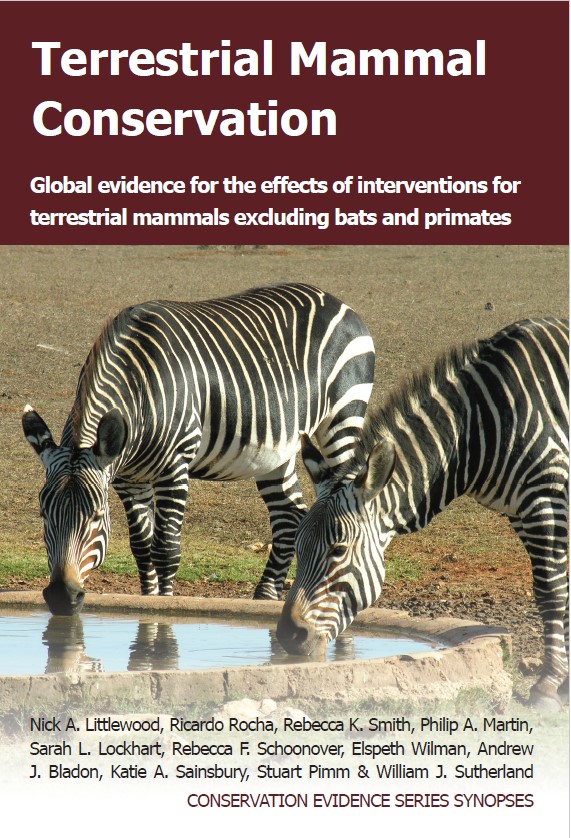Actions to conserve biodiversity
We have summarised evidence from the scientific literature about the effects of actions to conserve wildlife and ecosystems.
Review the evidence from the studies
Not sure what Actions are? Read a brief description.
Search for evidence
e.g. "frogs chytrid"
294 Actions found
Refine
Hide
294 Actions found
Download Actions
| 0 selected |
|
Order results by:
| Action | Effectiveness | Studies | Category | |
|---|---|---|---|---|
|
Use visual deterrents (e.g. scarecrows) to deter predation of livestock by mammals to reduce human-wildlife conflict Action Link |
Unknown effectiveness (limited evidence) | 2 |
|
|
|
Translocate predators for ecosystem restoration Action Link |
Likely to be beneficial | 2 |
|
|
|
Provide diversionary feeding to reduce predation of livestock by mammals to reduce human-wildlife conflict Action Link |
Unknown effectiveness (limited evidence) | 2 |
|
|
|
Install metal grids at field entrances to prevent mammals entering to reduce human-wildlife conflict Action Link |
Likely to be beneficial | 2 |
|
|
|
Use lights and sound to deter crop damage by mammals to reduce human-wildlife conflict Action Link |
Unlikely to be beneficial | 2 |
|
|
|
Place captive young with captive foster parents Action Link |
Unknown effectiveness (limited evidence) | 2 |
|
|
|
Preserve genetic material for use in future captive breeding programs Action Link |
Unknown effectiveness (limited evidence) | 2 |
|
|
|
Remove trees and shrubs to recreate open areas of land Action Link |
Likely to be beneficial | 2 |
|
|
|
Translocate crop raiders away from crops (e.g. elephants) to reduce human-wildlife conflict Action Link |
Trade-off between benefit and harms | 2 |
|
|
|
Use light/lasers to deter crop damage by mammals to reduce human-wildlife conflict Action Link |
Unknown effectiveness (limited evidence) | 2 |
|
|
|
Use fire to deter crop damage by mammals to reduce human-wildlife conflict Action Link |
Likely to be beneficial | 2 |
|
|
|
Translocate mammals away from sites of proposed energy developments Action Link |
Unknown effectiveness (limited evidence) | 2 |
|
|
|
Train captive-bred mammals to avoid predators Action Link |
Unknown effectiveness (limited evidence) | 2 |
|
|
|
Remove/control non-native plants Action Link |
Unknown effectiveness (limited evidence) | 2 |
|
|
|
Leave headlands in fields unsprayed Action Link |
Likely to be beneficial | 2 |
|
|
|
Manage vegetation using grazing by wild herbivores Action Link |
Unknown effectiveness (limited evidence) | 2 |
|
|
|
Build fences around protected areas Action Link |
Unknown effectiveness (limited evidence) | 2 |
|
|
|
Restore or create savannas Action Link |
Likely to be beneficial | 2 |
|
|
|
Remove or control competitors Action Link |
Unknown effectiveness (limited evidence) | 2 |
|
|
|
Apply fertilizer to vegetation to increase food availability Action Link |
Unknown effectiveness (limited evidence) | 2 |
|
|
|
Train mammals to avoid problematic species Action Link |
Unknown effectiveness (limited evidence) | 2 |
|
|
|
Control ticks/fleas/lice in wild mammal populations Action Link |
Unknown effectiveness (limited evidence) | 2 |
|
|
|
Install acoustic wildlife warnings along roads Action Link |
Unknown effectiveness (limited evidence) | 2 |
|
|
|
Modify vegetation along railways to reduce collisions by reducing attractiveness to mammals Action Link |
Likely to be beneficial | 2 |
|
|
|
Prohibit or restrict hunting of particular sex/ breeding status/age animals Action Link |
Unknown effectiveness (limited evidence) | 2 |
|
Download Actions
| 0 selected |
|

Terrestrial Mammal Conservation - Published 2020
Terrestrial Mammal Conservation
Watch this search
If you are familiar with RSS feeds, please click the button below to retrieve the feed URL:
RSS feed for this searchIf you are unfamiliar with RSS feeds, we would suggest reading this BBC article.
Unfortunately, due to the number of feeds we have available, we cannot provide e-mail updates. However, you could use tools such as Feed My Inbox to do this for you.
What are 'Individual studies' and 'Actions'?
Individual studies
An individual study is a summary of a specific scientific study, usually taken from a scientific journal, but also from other resources such as reports. It tells you the background context, the action(s) taken and their consequences.
If you want more detail please look at the original reference.
Actions
Each action page focuses on a particular action you could take to benefit wildlife or ecosystems.
It contains brief (150-200 word) descriptions of relevant studies (context, action(s) taken and their consequences) and one or more key messages.
Key messages show the extent and main conclusions of the available evidence. Using links within key messages, you can look at the paragraphs describing each study to get more detail. Each paragraph allows you to assess the quality of the evidence and how relevant it is to your situation.
Where we found no evidence, we have been unable to assess whether or not an intervention is effective or has any harmful impacts.





)_2023.JPG)














